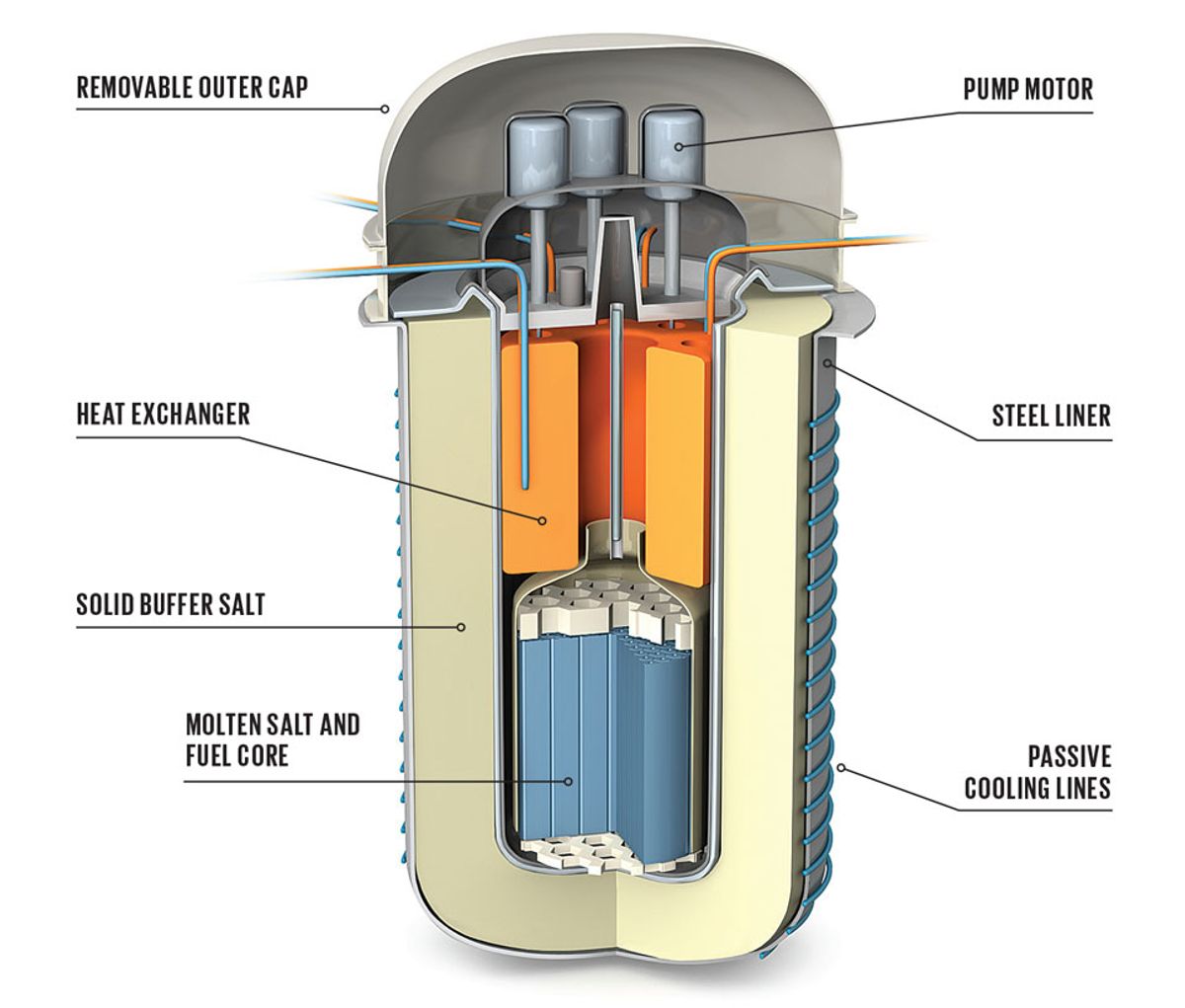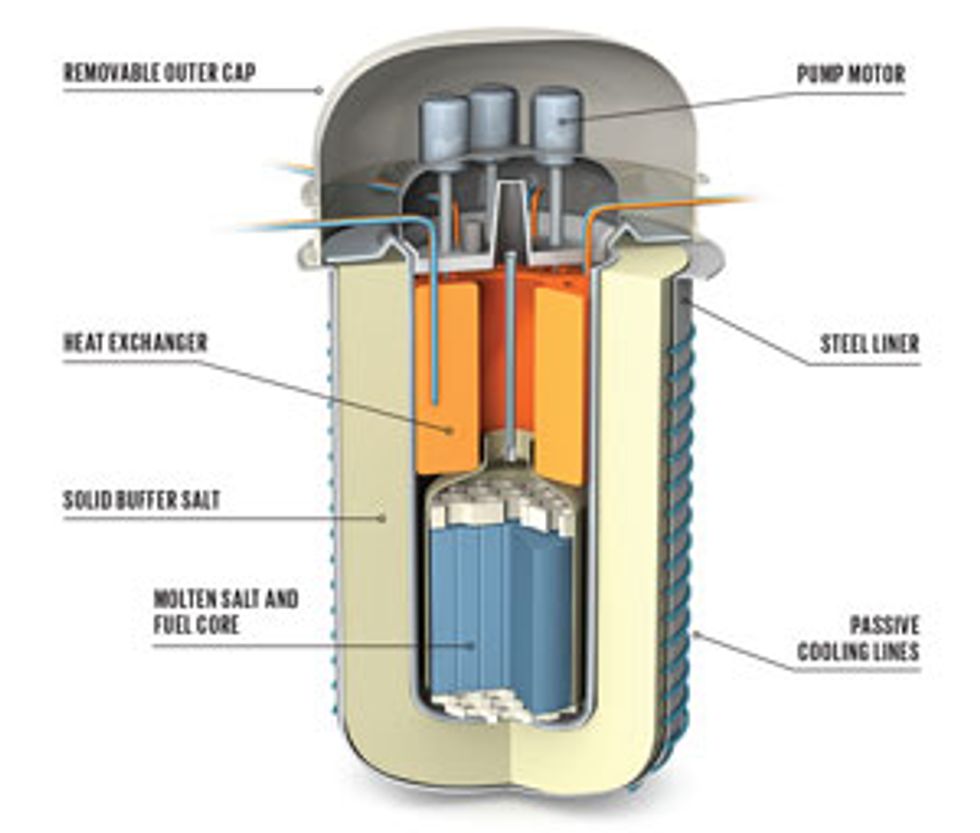A Fluid Furnace: In Terrestrial Energy’s alternative nuclear reactor, uranium is dissolved in molten salt at the reactor’s core. Heat exchangers move energy out of the hot core to turn a turbine generator. If power is lost to the pumps, heat passively dissipates into a solid buffer of salt.
There’s more than one design for a nuclear reactor, but you wouldn’t know it judging by the array of aging light-water reactors in operation around the world. A number of potentially better reactor types have been stuck on drawing boards or at the experimental stage for decades. Now a handful of small companies say the best way to commercialize these advanced concepts is to hitch nuclear to the distributed-energy bandwagon.
One vision for the future of nuclear involves smaller versions of today’s gigawatt-scale behemoths. Building a power plant in smaller chunks, about one third or less the size of today’s plants, should lead to lower up-front costs, site flexibility, and the ability to add more units as needed.
But others believe it’s time to move past the light-water reactor. The idea is to modernize experimental reactor designs and make the leap from the lab to the marketplace.
“We’re seeing a new innovation pathway emerging,” says Richard Lester, the head of MIT’s department of nuclear science and engineering. “Early-stage companies are getting into the business and seeking to develop new nuclear technologies—that’s a big shift.”
Terrestrial Energy, in Mississauga, Ont., Canada, for example, is seeking to build a molten salt reactor, one of which was built and operated at the Oak Ridge National Laboratory in the 1960s.
In a conventional light-water reactor, uranium rods are submerged in water. The nuclear reaction of uranium generates heat, and the hot water is continually circulated through the core to produce steam and turn a turbine. In Terrestrial’s reactor, low-enriched uranium fuel is dissolved in molten salt. Aided by pumps and heat exchangers, the heat from that bath of fuel and molten salt produces steam to generate electricity. A molten salt reactor can use more of the available energy in the fuel and is safer than a water-cooled reactor, the company says. In the case of a loss of power, the heat from the reactor would dissipate, moving by convection from the core to an outer shell layer of solid salt, so it wouldn’t require pumps to cool it and keep it from melting down, says CEO Simon Irish.
Terrestrial’s business plan is unconventional as well. Instead of only banking on building power plants for utilities, its management thinks it can get a commercial foothold in niche markets, including locations that now rely on diesel generators for electricity, such as remote locations in Canada or island nations. The reactor can produce both electricity and high-temperature heat, which is useful in many industrial settings, notes Irish.
The main component would be small enough to fit on a rail car or truck to simplify installation. And the reactor, able to generate 32.5 megawatts of electricity, would be sealed so that it could operate for about seven years before being decommissioned. Terrestrial plans to start the licensing process in Canada later this year and have designs ready for engineering blueprints by 2016.
“At the boundary between the laboratory—where we know it works—and the market, you have to have certain features, namely operational simplicity and a safety case you can demonstrate to a regulator to get an operating license,” says Irish. “That’s the essence of our innovation.”
Some companies intend to make even smaller reactors for distributed energy. Boston-based UPower Technologies’ nuclear generator would produce between 1 and 2.5 MW from a reactor the size of a shipping container. The core vessel would have a metal block with nuclear fuel at the base; tubes, partially filled with liquid, that fit into the block would transfer heat away through convection, rather than by pumping water through the core. As a first step toward seeking a license, UPower is designing tests of its heat removal system.
Quebec-based StarCore Nuclear intends to build a commercial high-temperature gas reactor, a variant of the pebble-bed, helium-cooled design developed in Germany in the 1960s. Fuel is contained in tennis-ball-size “pebbles” that generate heat, which is transferred via helium. Because it operates at high temperature, the design can be more efficient at generating electricity, and the reactor can cool itself by natural circulation in the case of an emergency or loss of power, say company executives.
StarCore’s plans call for building a generator to produce 10 MW of electricity as well as heat. Like UPower, StarCore is initially targeting remote locations, such as mining operations, which pay a lot of money for heat and electricity. The company hopes to build and commission one installation in five years, “if we’re lucky,” says CEO David Dabney.
StarCore’s founders see a future with many different nuclear technologies, including reactors that burn today’s spent nuclear fuel. But to get there, new nuclear needs to start small, they say. “There are lots of other reactors that offer great capabilities,” says StarCore chief technology officer David Ashley Poole. “We need to do that, but the first ones need to be as simple and safe as possible to get them out of the laboratories and into the ground, and get public acceptance.”
It will take years for any new nuclear technology to be licensed and, most likely, years to get potential customers and partners to buy into the concept of mininuclear plants. A key time frame is the late 2020s and early 2030s, which is when many nuclear plants in the United States will likely go off-line, says MIT’s Lester. “It is a long game, and it will hinge on whether these innovators and investors can find large companies to work with to commercialize the technology,” he says. “Given the environment, it’s not an unreasonable bet.”
This article originally appeared in print as “Is This the Age of Alternative Nuclear Power?.”
About the Author
Martin LaMonica is a former contributor to IEEE Spectrum’s Energywise blog. He’s now environment and energy editor at The Conversation.

